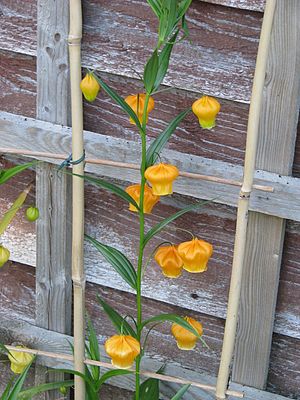Lantern lily
| Lantern lily | ||||||||||||
|---|---|---|---|---|---|---|---|---|---|---|---|---|

Lantern Lily ( Sandersonia aurantiaca ) |
||||||||||||
| Systematics | ||||||||||||
|
||||||||||||
| Scientific name of the genus | ||||||||||||
| Sandersonia | ||||||||||||
| Hook. | ||||||||||||
| Scientific name of the species | ||||||||||||
| Sandersonia aurantiaca | ||||||||||||
| Hook. |
The sandersonia ( Sander aurantiaca ), also Chinese Lantern Lily , China lantern , gold bells or Christmas bells called, is the only kind of plant genus Sandersonia within the family of colchicaceae (Colchicaceae). The common names refer to the shape and color of the flowers; Chinese lantern lily not because it comes from China, but because the flowers are shaped like a Chinese lantern . It is native to southern Africa and is used as an ornamental plant.
description
Appearance and leaf
The lantern lily grows as a deciduous, perennial herbaceous plant . As a storage organ, this geophyte forms subterranean, rather deep-seated rhizomes at both ends of which there are bulbous thickenings. The storage organ at the ends of the thickening continues to grow with each growth period. In spring, new above-ground parts of the plant are formed. The independently upright to climbing stems reach heights of growth from 1 to 1.5 meters.
The alternate and spirally arranged leaves on the stem are sitting. The simple leaf blades are lanceolate and sometimes taper into a tendril at their upper ends . The leaf blades have three main nerves.
blossom
The nodding flowers stand individually on long pedicels in the axils of the upper leaves. The showy, lantern-shaped, hermaphrodite flowers are radial symmetry and threefold and about 25 mm long. The six identical bloom bracts are fused bell-shaped and light to dark orange in color. There are two circles with three stamens each.
Fruit and seeds
The capsule fruits contain many seeds. The small, hard, brown seeds are fleshy and, unlike Gloriosa, do not have a parchment-like seed coat (testa).
Chromosome number
The number of chromosomes is 2n = 24.
Occurrence
The lantern lily is common in eastern southern Africa . There are sites in Swaziland and the South African provinces of Eastern Cape , Mpumalanga and KwaZulu-Natal .
The lantern lily thrives on grassland, sometimes on the edge of bushes, on cool, damp slopes at altitudes between 200 and 1800 meters. Only in areas with few herbivores and fires.
Sandersonia aurantiaca is listed in the Red List of Endangered Species . It is considered very rare there, but its endangerment is declining. It is endangered by flower picking, degradation , agriculture and forestry, especially arable farming and overgrazing. In some locations their stocks have expired. The remaining locations are protected.
Systematics
The first description of the species Sandersonia aurantiaca and the genus Sandersonia was in 1853 by William Jackson Hooker in Botanical Magazine , plate 4716. The genus name Sandersonia honors the Scottish journalist, trader, plant collector and amateur botanist John Sanderson (1820–1881), who lived in KwaZulu- Natal stopped. The specific epithet aurantiaca is derived from the Latin word for orange and refers to the color of the flowers.
Sandersonia aurantiaca is the only species of the genus Sandersonia from the tribe Colchiceae within the family Colchicaceae ; it was formerly part of the Liliaceae family.
use
The lantern lily is used as an ornamental plant in tropical to subtropical parks and gardens. As a cut flower, the lantern lily has a long shelf life. The main country for growing as cut flowers is New Zealand. It is not frost hardy .
The Zulu used Sandersonia aurantiaca as an aphrodisiac and, together with other plant species, as a bath additive against calamities. All parts of the plant are poisonous due to colchicine .
Common names in other languages
Trivial names in other languages are: Chinese-lantern Lily (English), Christmas Bells (English), golden-lily-of-the-valley (English), Geelklokkie ( Afrikaans ), Geelklokkies (Afrikaans), Ihlamvu ( zulu ), Ihlamvu Lasenhla (zulu), Umagobongwana (zulu), Ushayabhici (zulu), lyktlilja (Swedish).
swell
- Graham Duncan, 2006: Sandersonia aurantiaca Hook. at PlantZAfrica of the South African National Biodiversity Institute = SANBI.
- John Manning: Field guide to wild flowers of South Africa, Lesotho and Swaziland. Struik Nature, Cape Town 2009, ISBN 978-1-77007-758-4 .
Individual evidence
- ↑ a b Rafaël Govaerts (ed.): Sandersonia. In: World Checklist of Selected Plant Families (WCSP) - The Board of Trustees of the Royal Botanic Gardens, Kew . Retrieved March 22, 2013.
- ↑ a b c d e f Graham Duncan: Sandersonia aurantiaca Hook. at PlantZAfrica of the South African National Biodiversity Institute = SANBI. 2006, accessed March 22, 2013
- ↑ a b c d e John Manning: Field guide to wild flowers of South Africa, Lesotho and Swaziland. Struik Nature, Cape Town 2009, ISBN 978-1-77007-758-4 : Sandersonia aurantiaca on p. 98.
- ^ Tropicos. (tropicos.org)
- ↑ a b c d Sandersonia aurantiaca in the Germplasm Resources Information Network (GRIN), USDA , ARS , National Genetic Resources Program. National Germplasm Resources Laboratory, Beltsville, Maryland. Retrieved March 22, 2013.
- ↑ a b c d e D. Raimondo, L. von Staden, W. Foden, JE Victor, NA Helme, RC Turner, DA Kamundi, PA Manyama: Entry in Red List of South African Plants . 2009, accessed March 22, 2013
- ↑ Sandersonia aurantiaca at Tropicos.org. Missouri Botanical Garden, St. Louis, accessed March 22, 2013.
- ↑ Lotte Burkhardt: Directory of eponymous plant names . Extended Edition. Botanic Garden and Botanical Museum Berlin, Free University Berlin, Berlin 2018. (bgbm.org)
- ↑ Gordon Cheers (Ed.): Botanica. The ABC of plants. 10,000 species in text and images . Könemann Verlagsgesellschaft, 2003, ISBN 3-8331-1600-5 , p. 818 .

